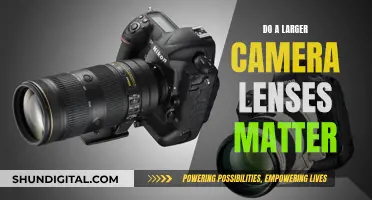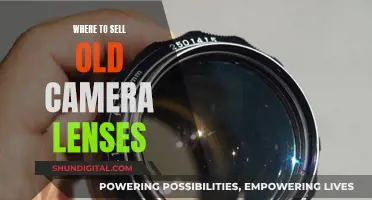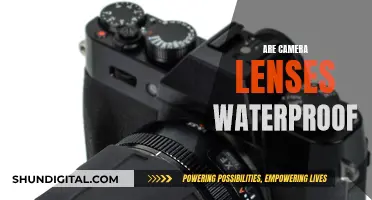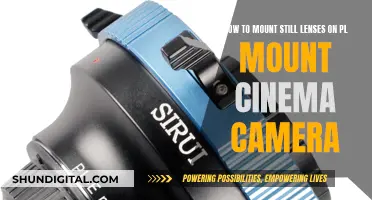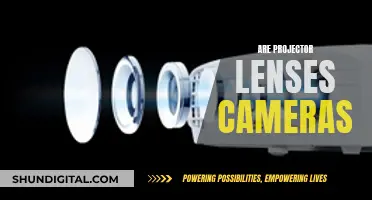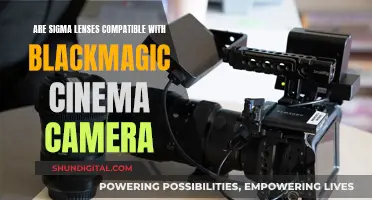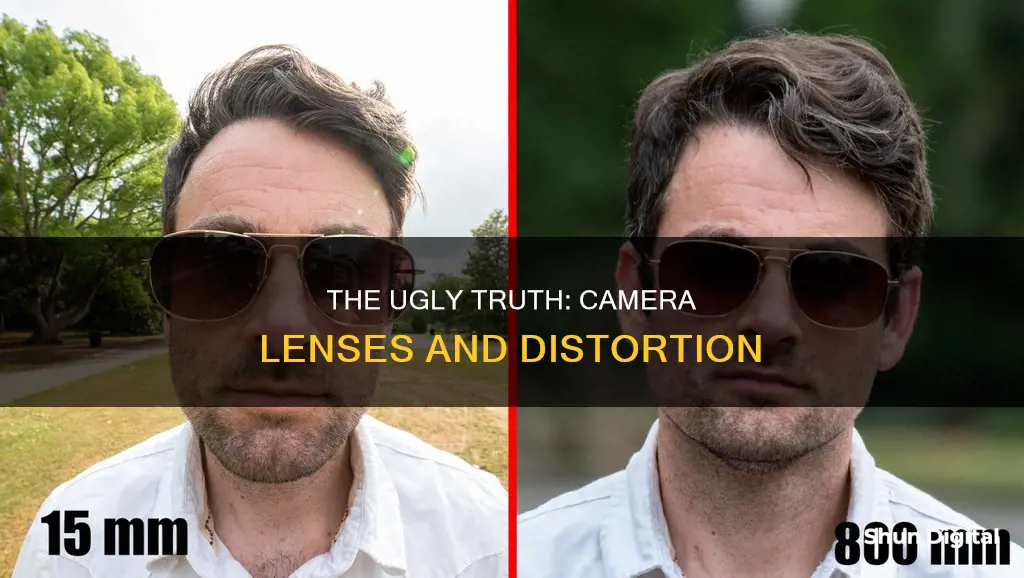
Ever wondered why you look prettier in some photos and uglier in others, even with the same smile and lighting? It's all about the camera lens. Camera lenses tend to bend light and capture a two-dimensional picture in a limited field, which is where lens distortion occurs. This distortion can make a face look prettier or uglier than it actually is. The shorter the focal length, the more field of view you can capture, and the more distorted your face will look. As you increase the focal length, the distortion becomes more subtle.
| Characteristics | Values |
|---|---|
| Camera lenses distort images | They bend light rays and capture a two-dimensional picture in a limited field |
| Focal length affects distortion | Shorter focal length causes more distortion, making faces look extremely deformed; longer focal length can also distort, making faces look flatter and wider |
| Distance from camera affects distortion | The closer the subject is to the camera, the more distorted the image becomes |
| Anatomy affects distortion | Some people are "photogenic" and their facial features are suited to most camera lenses |
What You'll Learn

The shorter the focal length, the more field of view you can capture
The focal length of a lens is the distance between the plane of the camera sensor and the optical centre or nodal point of the lens. This determines the lens's angle of view. The longer the focal length, the narrower the area of the scene captured by the lens. Conversely, the shorter the focal length, the wider the angle of view.
A shorter focal length allows for a broader field of view, making it ideal for capturing sweeping landscape shots or environmental portraits. This is because shorter focal lengths have a wide angle of view, which makes subjects appear smaller and requires photographers to stand closer to fill the frame. They are also useful for photographing large groups or shooting in small spaces.
Short focal lengths are typically found in wide-angle lenses, which are used in architectural, documentary, and landscape photography. These lenses have a focal length of up to around 35mm and are also popular with vloggers who want to include a lot of their environment in the frame.
It's worth noting that shorter focal lengths can also cause distortion, especially around the edges of the image. This can affect straight lines, so extra care needs to be taken if maintaining straight lines is important for the shot.
The Intriguing Pricing of Camera Lenses: Factors and Features
You may want to see also

Lenses bend light rays
Lenses play a significant role in photography, and understanding how they work can help explain why some photos turn out prettier than others.
The type of lens also affects the degree of distortion. A fish-eye lens, for instance, is known for its extreme distortion, while other lenses may produce more flattering effects. The anatomy of the subject's face also comes into play, with certain individuals appearing more photogenic depending on the camera and the angle used.
The position of the subject within the frame can also impact their appearance. Placing someone in the centre of the frame might make them look better, while moving them to the sides could alter their appearance due to the distortion being more noticeable in those areas.
The focal length of a lens influences the amount of bending of light rays, which results in the deformation of the captured image. Longer focal lengths, such as 350mm, can cause a face to appear flatter and wider, while shorter focal lengths tend to distort the image inward, making the subject look thinner.
In conclusion, the bending of light rays by camera lenses is a critical factor in understanding the 'uglification' or beautification of a face in photographs. The focal length, type of lens, subject's anatomy, and position within the frame all interplay to create the final image, explaining why some people appear more photogenic than others in certain cameras and angles.
Infinity Focus: Are Camera Lenses Capable?
You may want to see also

The distortion gets more subtle as you go up in focal length
As you go up in focal length, the distortion becomes more subtle and less obvious. Since this subtler distortion is not as noticeable, your mind just accepts the image, thinking that this is what the person looks like. This is why some people are "photogenic" with certain cameras and at certain angles, and look horrible with others.
The same happens with larger focal lengths. At 350mm there is also a distortion of reality: the face of the model becomes flatter and wider. In theory, shooting with a focal length like 135mm would produce the best, most accurate results, but there is no right or wrong here. It depends on the subject's anatomy.
You can even see this effect without changing the lens focal length. Placing some people in the center of the frame can make them look better, especially from a distance. Then, as you move them to the sides of the frame, they look slightly different. The distortion is more obvious near the sides, and it is enough to make them less attractive.
Point-and-Shoot Cameras: Interchangeable Lenses or Not?
You may want to see also

The phenomenon is called ''forced perspective'
The phenomenon is called forced perspective. This is a technique used in photography and filmmaking to create an optical illusion, making objects appear larger, smaller, closer, or farther away than they are in reality. Forced perspective is achieved by manipulating the distance between subjects and the line of sight from which the image is captured.
Photographers can use forced perspective to make their subjects appear more attractive or unattractive. The technique can be used to distort the image by altering the focal length of the lens. A shorter focal length will distort the image inward, making the subject appear thinner, while a longer focal length will make the subject appear flatter and wider.
Forced perspective photography can be achieved by following a few simple steps. Firstly, it is important to keep the image simple, with only the subject, another object, and a clean background. The placement of the subject is crucial to creating the optical illusion, and the rule of thirds and rule of space should be considered when composing the photo. A wide-angle lens is recommended as it provides more depth of field, allowing both objects to be in focus. Additionally, a narrow aperture, such as f/16, should be used to ensure that everything in the image is sharp and in focus.
Forced perspective can be used to create unique and captivating images that stand out from the billions of photos posted on social media platforms like Instagram. It is a fun and creative technique that can be used to make objects appear larger or smaller, or to create illusions such as a person holding up a tall building. By manipulating the perspective, photographers can create images that cannot exist in real life, adding a touch of creativity and abstractness to their work.
How Does an Eclipse Affect Camera Lenses?
You may want to see also

The distance from the camera, not the lens width, is what matters
When it comes to photography and videography, the distance from the camera can significantly impact the final product. While lens width or focal length can cause distortion, the distance from the camera plays a crucial role in how the subject is portrayed and how versatile the content is.
Lens distortion is influenced by the subject's distance from the camera. Lenses capture light rays and bend them, creating a two-dimensional image with a limited field of view. The shorter the focal length, the more distortion occurs, making faces and objects appear deformed. This distortion can be subtle, and sometimes it can make a face appear prettier or uglier than it is in reality.
The distance from the camera determines how much of the subject's anatomy is captured in the frame. A greater distance allows for a wider field of view, capturing more of the environment and less focus on the subject. On the other hand, being closer to the camera results in a more cropped image, highlighting the subject's features. This distance can be crucial in emphasising certain aspects of the subject's appearance, making them look better or worse depending on the angle and framing.
Additionally, the distance from the camera affects the versatility of the content. Being sufficiently far away from the camera allows for more cropping options. For example, a video recorded from a distance can be easily reformatted from a landscape to a square or vertical aspect ratio, making it suitable for different social media platforms like TikTok or Instagram Reels. This increases the reach of the content by accommodating different platforms' formats.
The distance from the camera also influences the perceived relationship between the subject and their surroundings. A wide shot, for instance, establishes the subject's position in the frame and their relationship to the environment. It provides context and emphasises action and movement. On the other hand, a close-up shot emphasises the character over the setting, creating a more dramatic and intimate feel.
In conclusion, while lens width or focal length plays a role in uglifying or beautifying a face, the distance from the camera is equally important. The distance impacts the distortion, framing, versatility, and context of the image or video. By adjusting the distance from the camera, one can manipulate the portrayal of the subject to achieve the desired effect.
Cleaning Camera Lenses: A Step-by-Step Guide
You may want to see also
Frequently asked questions
The distortion of your face in photos is due to the lens and its focal length. The shorter the focal length, the more field of view is captured, and the more distorted your face will look.
In theory, shooting with a focal length of around 135mm would produce the most accurate results. However, there is no right or wrong answer, as it depends on your anatomy.
Professional photographers can adjust the focal length to make their subjects appear at their best. They can also use distance from the subject, camera angle, lighting, and posing to change a person's appearance dramatically without editing.


